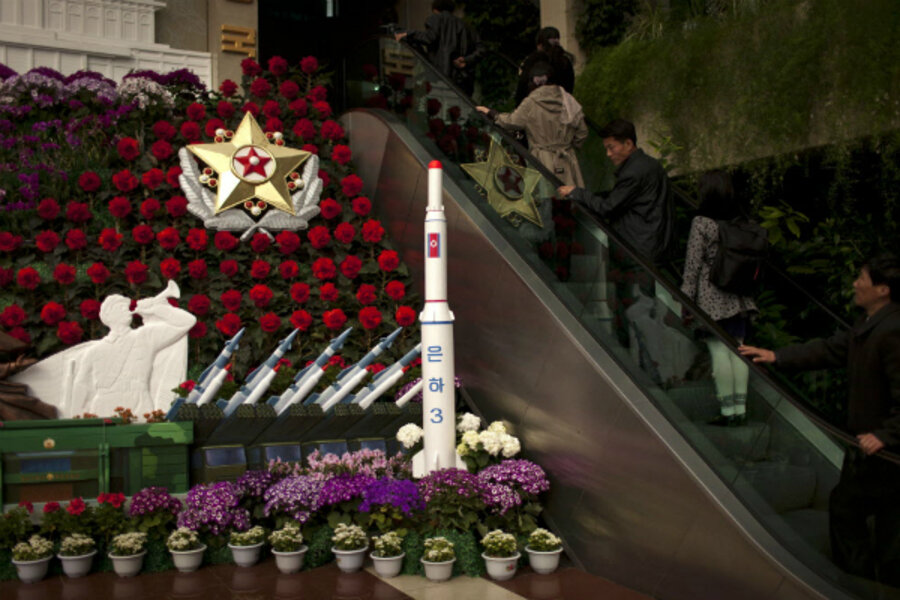North Korea nuclear missiles: How startling is Pentagon assessment?
Loading...
| Washington
A new US intelligence report says North Korea may have the ability to mount a nuclear warhead on top of a ballistic missile. This startling bit of information was made public at a congressional hearing on Thursday when Rep. Doug Lamborn (R) of Colorado read it out of a previously classified Defense Intelligence Agency report.
The DIA has “moderate confidence” that Pyongyang has made its nuclear devices small enough to fit missiles, noted Representative Lamborn. The lawmaker added that the Pentagon’s intelligence arm also believes that “reliability will be low” when it comes to these possible warheads.
Yikes! Is this as startling as it sounds? Given the harsh rhetoric that’s been coming out of North Korea in recent weeks, the idea of Pyongyang’s young leader (and friend of Dennis Rodman) Kim Jong-un with his finger on the button is not reassuring.
First, it’s important to note that this DIA assessment does not necessarily reflect the thinking of the entire US intelligence apparatus. Plus, if read carefully, it holds only that North Korea may have rudimentary knowledge – not an arsenal of long-range missiles with nuclear weapons on their tips.
This can be seen in the fact that the Defense Department itself tried to roll back the DIA’s conclusion a bit after it was disclosed.
“In today’s House Armed Services Committee on the Department of Defense budget, a member of the committee read an unclassified passage in a classified report on North Korea’s nuclear capabilities. While I cannot speak to all the details of a report that is classified in its entirety, it would be inaccurate to suggest that the North Korean regime has fully tested, developed, or demonstrated the kinds of nuclear capabilities referenced in this passage,” said Pentagon spokesman George Little in a statement issued Thursday night.
Second, it’s also crucial for context to know that many nonproliferation experts outside the government already believe North Korea has the ability to make a nuclear warhead small enough to fit a short- or medium-range ballistic missile. In that sense the DIA is only saying what they believe.
For instance, in a Feb. 13 report on North Korea’s nuclear miniaturization, David Albright, president of the Institute for Science and International Security in Washington, concluded that Pyongyang probably can make a nuclear device just small enough in diameter to fit on a Nodong, a short-range missile that could reach South Korea.
“Pyongyang still lacks the ability to deploy a warhead on an ICBM, although it shows progress at this effort,” Mr. Albright wrote.
Others note that Pentagon spokesman Little’s statement must be read carefully: It says that North Korea does not have a “fully tested” arsenal, for instance. That does not preclude a partly or untested nuclear capability.
Third, North Korea’s recent increase in belligerence may be the result of its nuclear progress.
Right now, Pyongyang has a strategic military problem: Its conventional forces are aging and decrepit compared with US and South Korean counterparts. That means that North Korea’s leadership may have a declining confidence in the ability of its military structure to keep the nation secure, writes Nautilus Institute East Asia expert Alexander Mansourov in a recent post on the North Korea analysis blog 38 North.
In the North Korean calculus, nuclear weapons may offer a way out of this box.
“The acquisition of nuclear weapons may have endowed the North Korean regime with a false sense that this new capability offers a solution to its deteriorating security predicament and a perception of invincibility,” writes Mr. Mansourov.
That may be the bottom line here: Even a rudimentary North Korean nuclear weapon capability could change the Pyongyang regime’s behavior and the response of the US and its allies. Though the DIA judges North Korean nuclear weapons “unreliable," does anyone really want to find out if they work?
Thus the US-South Korea-North Korea relationship may now be entering a new and even more difficult period.
North Korea “may provoke more often from behind safety of nuclear capabilities. Like seat belts,” tweeted East Asia proliferation expert Jeffrey Lewis of the James Martin Center for Nonproliferation Studies in Monterey, Calif., on Thursday night.








